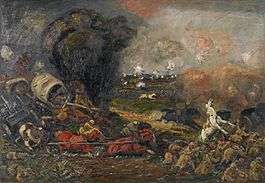Ludwig Dettmann

Ludwig Julius Christian Dettmann (25 July 1865, Adelby, near Flensburg - 19 November 1944, Berlin) was a German Impressionist painter.
Biography
His father was a customs officer who was transferred to Hamburg while he was still a small child.[1] After some studies at a local arts and crafts school, he transferred to the Prussian Academy of Arts, where he studied with Eugen Bracht and Franz Skarbina. He originally worked as an illustrator.[2]
After 1891, he was a teacher at the drawing and painting school of the "Association of Berlin Artists".[3] In 1894, he won a small gold medal at the "Great Berlin Art Exhibition", a major annual event that ran from 1893 to 1969. (He would win a large gold medal there in 1909).
In 1897, he and his wife moved to Schwerin, where their son, the art historian Gerd Dettmann (1897-1943) was born. Under the influence of Max Liebermann, he turned to landscape painting in olis and watercolors. His first major project consisted of four murals at the town hall in Altona, depicting the city's history.[2]
In 1898, he was one of the founders of the Berlin Secession and, together with Max Liebermann, Walter Leistikow, Otto Heinrich Engel, Oskar Frenzel, Curt Herrmann and Fritz Klimsch, was a member of the advisory board. In 1900, he was appointed Director of the Kunstakademie Konigsberg. He also belonged to the committee charged with selecting artists for the popular trading cards in Stollwerck chocolates.

In 1915, he organized the Army and Marine exhibition, composed of heroic war and battle scenes. It was shown at the Berlin Academy and at the Königsberger Art Association the following year. He contributed portraits of Generals Erich Ludendorff and Paul von Hindenburg. For the remainder of the war, he was an official war artist.[2]
After the war, he returned to Berlin. In 1923, he illustrated both volumes of Weltbrand – Deutschlands Tragödie 1914–1918 (Conflagration, Germany's Tragedy), a detailed examination of the war and its aftermath by the novelist Walter Bloem, an ardent nationalist.
After Hitler seized power, Dettmann joined the Nazi Party and served on the board of the "Reichsverband bildender Künstler Deutschlands" (Reich Association of Visual Artists). He would remain a party member until his death. In 1935, he was awarded the "Goethe-Medaille für Kunst und Wissenschaft". He was chairman of the "Association of Berlin Artists" for the year 1936-37.[2]
In 1938 he wrote Ostfront. Ein Denkmal des Deutschen Kampfes (Eastern Front, a Monument to the German Struggle). Shortly before his death in 1944, his name was added to the Gottbegnadeten list of artists crucial to Nazi culture. In 1946, Ostfront was placed on the "Liste der auszusondernden Literatur" ("weeded-out" literature), a list of Nazi works that were forbidden in the Soviet occupation zone.[4]
Selected paintings
- By the Waterlilies in the Moor
 Garden with Chair
Garden with Chair Wave
Wave The Autumn of Life
The Autumn of Life
References
- ↑ Biographical notes @ Flensburg online.
- 1 2 3 4 Biographies of Kunstakademie Konigsberg Directors @ Kant-Forschungsstelle.
- ↑ Verein der Berliner Künstler Brief history of the school.
- ↑ List of forbidden works @ Polunbi-Katalog.
Further reading
- Monika Potztal: Ludwig Dettmann 1865–1944. Zwischen Avantgarde und Anpassung. Boyens, Heide 2008 ISBN 978-3-8042-1249-7
- Dagmar Jestrzemski: Ludwig Dettmann Gemälde im Altonaer Rathaus ConferencePoint Verlag Hamburg 2011 ISBN 978-3-936406-35-1
External links
| Wikimedia Commons has media related to Ludwig Dettmann. |
- ArtNet: More works by Dettmann.
- Volume One of Weltbrand @ Google Books
- Brief biography @ Bei K.A.T.I. - Kultur und mehr... (blog)
- Literature about Ludwig Dettmann in the State Bibliography (Landesbibliographie) of Mecklenburg-Vorpommern
- Literature by and about Ludwig Dettmann in the German National Library catalogue